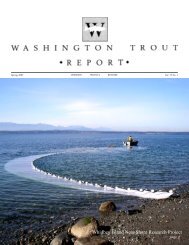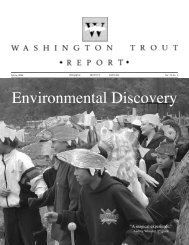Seafood Watch
Pacific Salmon - Wild Fish Conservancy
Pacific Salmon - Wild Fish Conservancy
- No tags were found...
Create successful ePaper yourself
Turn your PDF publications into a flip-book with our unique Google optimized e-Paper software.
<strong>Seafood</strong> <strong>Watch</strong>® Wild Pacific Salmon Report October 8, 2010<br />
Special Behaviors or Requirements: Existence of special behaviors that increase ease or<br />
population consequences of capture (e.g., migratory bottlenecks, spawning aggregations, site<br />
fidelity, unusual attraction to gear, sequential hermaphrodites, segregation by sex, etc., OR<br />
specific and limited habitat requirements within the species’ range)<br />
‣ No known behaviors or requirements OR behaviors that decrease vulnerability<br />
(e.g., widely dispersed during spawning)<br />
‣ Some (i.e., 1 - 2) behaviors or requirements<br />
‣ Many (i.e., > 2) behaviors or requirements<br />
Quality of Habitat: Degradation from non-fishery impacts<br />
Chinook, Coho, Sockeye, Chum, and Pink Salmon in AK<br />
‣ Habitat is robust<br />
‣ Habitat has been moderately altered by non-fishery impacts<br />
Chinook, Coho, Sockeye, Chum, and Pink Salmon in OR (north of Cape Falcon) and WA<br />
‣ Habitat has been substantially compromised from non-fishery impacts (e.g., dams,<br />
pollution, or coastal development) and thus has reduced capacity to support this<br />
species<br />
Evaluation Guidelines<br />
1) Primary Factors<br />
a) If ‘r’ is known, use it as the basis for the rank of the Primary Factors.<br />
b) If ‘r’ is unknown, then the most conservative rank from the remaining Primary Factors is<br />
the basis for the rank (in order of importance, as listed).<br />
2) Secondary Factors<br />
a) If the majority (2 out of 3) of the Secondary Factors rank as Red, reclassify the species<br />
into the next lower rank (e.g., Green becomes Yellow, Yellow becomes Red). No other<br />
combination of Secondary Factors can modify the rank from the Primary Factors.<br />
b) If the rank of the Primary Factors is Red AND the majority of Secondary Factors are also<br />
Red, inherent vulnerability represents a Critical Conservation Concern and the species<br />
receives a rank of “Critical” for this criterion and an overall seafood recommendation of<br />
“Avoid” regardless of the other criteria.<br />
Pacific Salmon in AK<br />
‣ Low (Inherently Resilient)<br />
Conservation Concern: Inherent Vulnerability<br />
Pacific Salmon in OR (north of Cape Falcon) and WA<br />
‣ Moderate (Inherently Neutral)<br />
37






